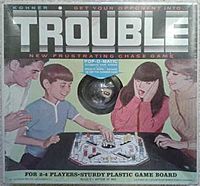Trouble (board game) facts for kids
 |
|
| Designer(s) | Frank Kohner, Paul Kohner, Fred Kroll |
|---|---|
| Publisher(s) | Hasbro, Winning Moves Games USA |
| Publication date | 1965 |
| Players | 2–4 |
| Setup time | 1 minute |
| Playing time | 30 minutes |
| Random chance | High (dice) |
Trouble is a fun board game where two to four players race to move their four game pieces around a board. The first player to get all their pieces to the finish line wins! You move your pieces by rolling a single die.
This game is known as Frustration in the UK and Kimble in Finland. It was created by the Kohner Brothers and first made by Irwin Toy Ltd. Later, Milton Bradley (which is now part of Hasbro) took over. Trouble first came out in America in 1965. Today, the classic version is sold by Winning Moves Games USA.
The idea for Trouble, its board, and how it's played came from an old Indian board game called Ludo. Another similar game, Headache, was also made by Milton Bradley. It has a different path for the pieces and uses cone-shaped pawns instead of the cylinder-shaped pieces found in Trouble.
Contents
How to Play Trouble
In Trouble, players try to move their pieces around the board. Here are some of the main rules:
- Sending Opponents Back: If you land on a space where another player's piece is, you can send their piece all the way back to their starting area.
- Safe Zones: Once your pieces reach the final four slots on the board, they are safe. No one can send them back to the start from there.
- No Blocking: Unlike some other race games, you cannot use your pieces to block opponents from moving.
- No Cheating: Players are not allowed to touch other players' pieces. If this happens, the piece's owner must roll the die again. Also, players cannot team up in the game.
The Pop-O-Matic Die Roller
The most famous part of Trouble is the "Pop-O-Matic" die container. This is a clear plastic dome with the die inside. It sits on a flexible sheet. To roll the die, you quickly press down on the bubble. This makes the sheet flex and the die tumble around inside.
The Pop-O-Matic makes a cool "popping" sound when you use it. It also keeps the die from getting lost. Plus, it makes sure everyone rolls the die fairly. This clever device allows players to roll the die very quickly, making the game move fast! The die inside usually has numbers (like 1, 2, 3) instead of dots.
Moving Your Pieces
You can only move a piece out of your starting area when you roll a 6.
- Extra Turn: If you roll a 6 at any point in the game, you get to take another turn. This is true even if you cannot move any of your pieces.
- Starting New Pieces: You can bring a new piece out of your start area even if you already have other pieces on the board. You can also start a new piece if another player's piece is on your "start" space. However, you cannot start a new piece if one of your own pieces is already on your "start" space.
- Unclear Rolls: If the die in the Pop-O-Matic doesn't land clearly on a number, you can tap the Pop-O-Matic. But you cannot press it again to re-roll while the die is still moving.
Different Versions of Trouble
Over the years, different versions of Trouble have been made.
Double Trouble
Double Trouble was first released in 1987 by Milton Bradley. Today, Winning Moves Games USA also makes it. In this version of Trouble, players move two arrow-shaped pieces around the board. These pieces go through special "detour wheels" on their way to the finish spaces.
Each player tries to get both of their pieces off the board. A piece is removed once it lands on one of the Finish spaces. The game board has four wheels built into it. If a player lands on a "Star" space, they must turn one of these wheels. If any pieces are on the chosen wheel, they stay there. However, they might end up on a different path than they planned! This means players can help themselves or make things harder for their opponents.
See also
 In Spanish: Trouble (juego de mesa) para niños
In Spanish: Trouble (juego de mesa) para niños

